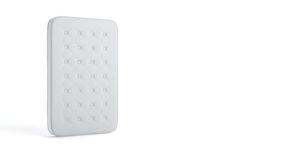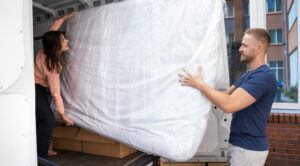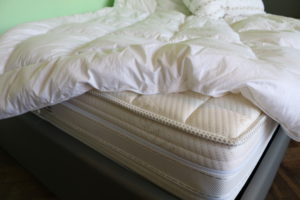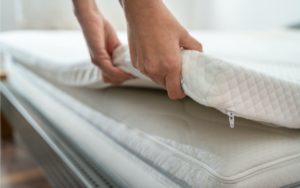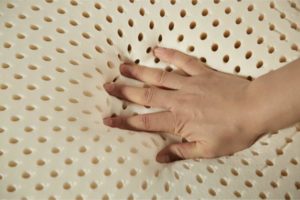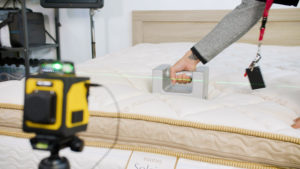How to Clean a Mattress
It might not seem like it, but your mattress is one of your most important possessions. Your mattress affects your sleep, which in turn affects nearly every aspect of your life. A quality mattress is also a significant investment – and one you’ll want to protect. That means learning how to clean a mattress, and how to maintain it, can help you get the most bang for your buck.
If left unchecked, your mattress can accumulate dead skin, dust mites, dirt, and a whole lot more. Regular mattress cleaning is important to extend the lifespan of your bed, and also to reduce allergies. Fortunately, cleaning a mattress doesn’t need to be complex. Keep reading to learn how to clean a mattress properly.
Let us help you find the perfect bed
Answer a few questions to find the right mattress for your unique needs
Recommended Method
1. Wash the Bedding
First and foremost, you’ll want to completely strip the bed and wash the sheets, pillowcases, and blankets. Check the label on your pillows to see if they are machine washable. Ideally, you’ll want to wash bedding in hot water in order to get rid of dust mites, but it’s important to follow the recommended care instructions to avoid potential shrinkage or fading. We recommend washing sheets weekly to help keep your mattress clean.
2. Assess the Damage
The best way to clean a mattress depends on how dirty it is and what stains are present. The technique for routine mattress cleaning will be different from the technique used to remove a spill or stain. You’ll want to closely check your mattress for stains, discoloration, smells, and other signs that will indicate that a specific area will need extra attention.
3. Gather Supplies
To properly clean a mattress, you’ll want to gather the following supplies:
- Cold water
- Baking soda
- Rags or towels for cleaning
- A gentle, bleach-free and unscented laundry detergent
- Dish soap, or an enzyme cleaner
When it comes to using soaps and cleaning products on your mattress, it’s important to be careful. You don’t want to use anything too harsh that could damage the delicate fabric of your mattress. Also, keep in mind that it’s difficult to completely remove detergents from a mattress, so you may wish to choose products with a mild scent.
4. Vacuum Thoroughly
Using your vacuum’s upholstery attachment, clean the entire surface of the mattress. Make sure to vacuum the sides of the bed to remove dust, and stretch the fabric to remove debris from seams.
5. Spot-Clean Where Needed
Check for stains and areas of discoloration. Carefully spot-clean these areas using the following method:
- Apply a small amount of cleaning solution to a clean cloth
- Gently blot the stained area with the cloth
- Apply cold water to a different clean cloth
- Gently blot the stained area with the water-soaked cloth
- Repeat if necessary, until the stain is removed
The main goal here is to use as little cleaning solution as possible, and to not over-soak the mattress. Never apply cleaning solution directly to the bed itself – instead, use a clean rag to apply and remove the solution.
The best solution to use for stain removal depends on the type of stain. For blood, sweat, urine, and other biological stains, the best option is typically a commercial enzyme cleaner. You can also use a mix of dish soap and water, using just the foamy suds that form on top.
Other types of stains respond better to different cleaning solutions. A common option is to make a 1:1 solution of cold water and hydrogen peroxide.
Regardless of the solution used, the method should be the same. In some cases, you may need to try multiple solutions in order to properly remove the stain.
6. Apply Baking Soda
After you have removed any visible stains and allowed the mattress cover to dry completely, apply a thin layer of baking soda over the entire surface of the mattress. Baking soda helps to absorb moisture and neutralize odor.
Once applied, simply leave the baking soda on the mattress for at least a few hours. If possible, open your bedroom windows to increase airflow.
7. Vacuum Thoroughly
Once you have let the baking soda sit on the surface of the mattress for at least a few hours, vacuum it up using the upholstery attachment. If the mattress was very dirty, you may wish to repeat steps 6 and 7, although this won’t be necessary in most cases.
8. Flip and Repeat
Flip the mattress over, and repeat steps 4 through 7. The underside of your mattress likely won’t have any visible stains, but it can still harbor a lot of dust, moisture, and more. If your mattress is not designed to be flippable, you can still clean the underside, but be cautious when flipping it over, and do not apply too much pressure to the mattress.
Depending on the type of mattress material and the severity of the stains/damage, you may have to troubleshoot in order to clean your bed properly. If you’re wondering how to clean a memory foam mattress, the process is largely the same. However, memory foam is not designed to get wet, so it’s important to use as little cleaning solution as possible.
Frequently Asked Questions
Generally, we recommend cleaning your mattress once every 6 months or so. Of course, if you spill something on your mattress, you should clean it immediately before the stain sets in. Using a quality mattress protector will reduce the need to clean your mattress as frequently. Regular cleaning will help extend the lifespan of your mattress – but it’s still important to know when it’s time for a new mattress, as well as how to dispose of your old mattress.
Because our recommended technique takes a long time, it’s best to clean your mattress first thing in the morning. That way, you can let the baking soda do its job for 8 hours or more, and have things cleaned up by the evening. Alternatively, the day before an overnight trip is also another good option, as you can let baking soda sit on your mattress overnight.
Maintaining your mattress starts by properly protecting it. In most cases, we recommend using a waterproof mattress protector, or at the very least a quality mattress pad. These products will help prevent the buildup of dust and other allergens, while also protecting your mattress from stains.
Regularly washing your sheets (around once per week) can also help. By proactively washing your bedding, you can reduce the buildup of allergens on your actual mattress.
Lastly, avoiding eating and drinking in bed is the best way to reduce the risk of accidental stains.

Still have questions? Ask our community!
Join our Sleep Care Community — a trusted hub of sleep health professionals, product specialists, and people just like you. Whether you need expert sleep advice for your insomnia or you’re searching for the perfect mattress, we’ve got you covered. Get personalized guidance from the experts who know sleep best.












